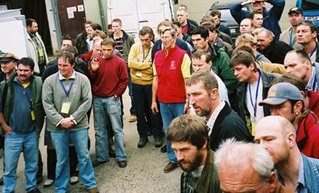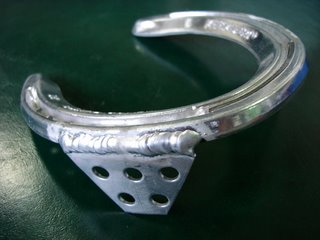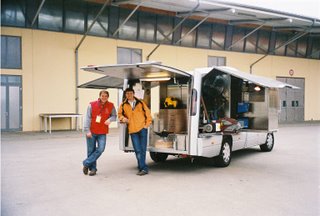
I used to think that farrier competitions were tense, but then I went to Germany and experienced the Luwex Hufsymposium. No competitions at this event (except for a shoeing rig contest that was terrific) but the pressure was on.
Lectures start at 7 a.m. and the last one begins at 10 p.m. I left Mike Savoldi from California still lecturing, however informally, to a dedicated group at midnight in one of the lecture halls.
The marathon shoeing sessions are the focus of the day, as the speakers are put to the test in front of more than 500 farriers from 21 nations. As the cases roll in (and keep rolling in) the speakers evaluate the hooves, shoe them in front of an audience with a camera crew with microphones dangling in their faces, and eager veterinarian translators hanging on their every word. Oh, and an American editor popping off a flash every few seconds. Three shoeing stations are going constantly, with a trade show in the same arena…and a pub, too.
The visiting speakers shoe the horses often without their own tools, in the case of the Americans, and with the use of borrowed, albeit high tech farrier rigs crafted from Mercedes vans. If James Bond needed a farrier rig, he'd probably model his fter Rob Renirie's or Bernard Duvernay's or maybe the super-tall Mercedes of Dieter Krohnert. It would be criminal to leave a scratch, or to have a horse rap one of these rigs with an impatient hoof.
The newly-shod horse is trotted out for all to see…and he’d better be more sound than he was a few hours before. That’s sometimes a tall order for a horse that has been sedated or even just standing around for the hours it can take to get through a demonstration.
Sigi, the Icelandic farrier who did a great demo, took "clinician macho" to a new level when he hopped on his demo horse and headed for the tolting track on the grounds to demonstrate (at high speed) what the horse could do now that his feet were straightened out.
In this photo you see Switzerland’s Bernard Duvernay (red vest, center) anxiously watching his demo horse trot after shoeing. Look at the faces of the farriers in the crowd. If you make a mistake, these guys will remember it. Bernie did just fine.
Bernard divides his time between running a high-tech multi-farrier practice in posh Geneva (where he cruises the lake on a beautifully restored 1920s tug boat) and serving as a farrier education consultant in Third World countries. He might pop up almost anywhere there are horses, but is most often in India. In Germany, he had a young Iranian apprentice visiting him, Ahmad Abad, who turned out to be half-American and a frequent guest here, so you may meet him at an event.
To learn more about Bernie’s important work around the world, visit
http://www.farrier.chTo learn more about the Luwex Symposium, visit
http://www.luwex.de










